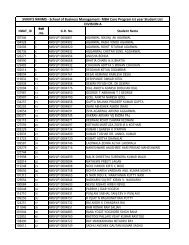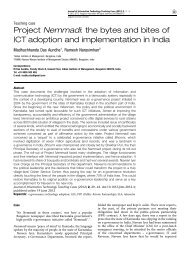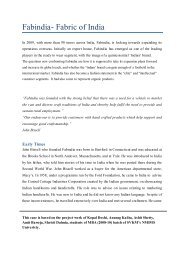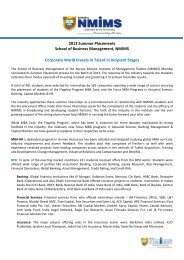3G WIRELESS TECHNOLOGIES - NMIMS
3G WIRELESS TECHNOLOGIES - NMIMS
3G WIRELESS TECHNOLOGIES - NMIMS
Create successful ePaper yourself
Turn your PDF publications into a flip-book with our unique Google optimized e-Paper software.
conditions, digital will sound better. Under<br />
slightly worse conditions, analog will<br />
experience static, while digital has occasional<br />
dropouts.<br />
3. <strong>3G</strong> Networking standards[6]<br />
The increased demands of radio interface lead to the<br />
development of the <strong>3G</strong> networks and technology, which<br />
are capable of providing higher bandwidth connections<br />
to more users simultaneously.<br />
There are two ways in which the radio access of the <strong>3G</strong><br />
would be provided, these are:<br />
a) The addition of new wideband radio<br />
technology to make use of a newly available<br />
radio spectrum.<br />
b) The evolution of current radio technologies to<br />
provide higher speed capabilities.<br />
There are two prominent radio transmission standards<br />
approved for <strong>3G</strong>, under IMT-2000 initiative, these are:<br />
a) Wideband Code Division Multiple (W-<br />
CDMA): It is an air interface standards found<br />
in the <strong>3G</strong> mobile technologies. It utilizes FDD<br />
duplexing method to achieve higher speeds and<br />
supports more users compared to most Time<br />
division multiplexing access (TDMA)<br />
schemes.<br />
b) CDMA 2000: Also called CDMA Multi-carrier<br />
cdma2000 is a <strong>3G</strong> standard which used CDMA<br />
channel access to send voices data and<br />
signaling data between mobile phones and cell<br />
sites.<br />
4. View of <strong>3G</strong> standards[6]<br />
There is a tree of standards for <strong>3G</strong> covering new Radio<br />
transmission technology (RU). A number of proposals<br />
for the IMT-2000 <strong>3G</strong> standard were submitted to the ITU<br />
during 1998. Since this time, the industry and standards<br />
bodies have coordinated their efforts to harmonize the<br />
IMT-2000 candidates and arrive at a smaller set of<br />
standards. The Operators Harmonization Group (OHG) -<br />
a group of major operators from all parts of the world -<br />
has played a key role in this process, and agreed on a set<br />
of standards in May 1999.<br />
This view of standard is very important as it provides an<br />
deep understanding of the various technologies that<br />
constitute the <strong>3G</strong> technology. It tells in detail that how<br />
the various technologies like GPRS, WCDMA, GSM,<br />
CDMA are linked together and perform together to<br />
produce the technology of <strong>3G</strong>. The table give below will<br />
3<br />
give you a formatted view of how it works. All these<br />
technologies are the fundamentals of wireless<br />
communication and were there even in 1G and 2G<br />
wireless technologies.<br />
Figure (1),[6]<br />
This family of standards includes one GDMA-based<br />
standard with three optional modes Multi-Carrier (Mc)<br />
Direct Spread (DS) and Time Division Duplex (TDD)<br />
and one TDMA hazed standard (EDGE). The radio<br />
standards can he combined with different core network<br />
standards (GSM MAP or ANSI-41) and operate in<br />
different frequency hands. The Multi-Carrier (Mc) mode<br />
is also called cdma2000 Mc; and the Direct Spread (DS)<br />
Mode is also called WCDMA. The UMTS standard<br />
covers WCDMA, TDD and GSM/MAP.<br />
5. Evolution to <strong>3G</strong> wireless technology[5]<br />
The Evolution to <strong>3G</strong> describes the updating of cellular<br />
mobile telecommunications networks around the world<br />
to use new <strong>3G</strong> technologies. This process is taking place<br />
over the period 1999 to 2010. Japan is the first country<br />
having introduced <strong>3G</strong> nationally, and in Japan the<br />
transition to <strong>3G</strong> is being largely completed during<br />
2005/2006. <strong>3G</strong> technologies enable network operators to<br />
offer users a wider range of more advanced services,<br />
while achieving greater network capacity through<br />
improved spectral efficiency.<br />
As of 2005, the evolution of the <strong>3G</strong> networks was on its<br />
way for a couple of years. The main reason for these<br />
changes are basically the limited capacity of the existing<br />
2G networks. The second generation of networks were<br />
built mainly for telephone calls and slow data<br />
transmission. Due to the rapid changes in technology,<br />
these factors do not meet the requirements of today's<br />
wireless revolution. The developments of so-called










